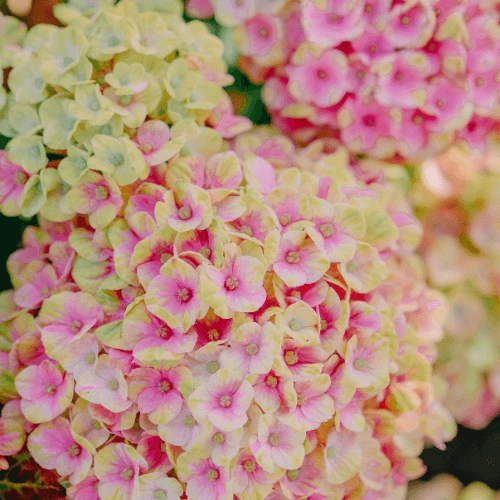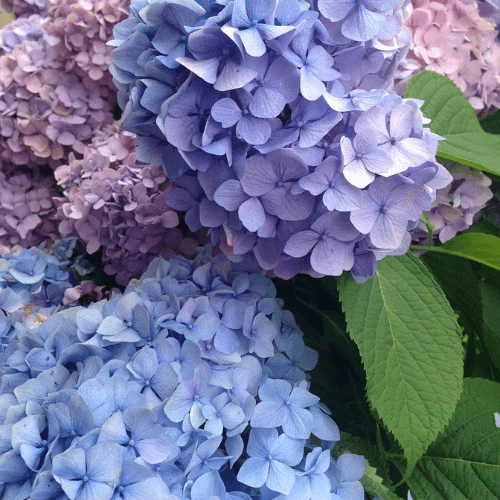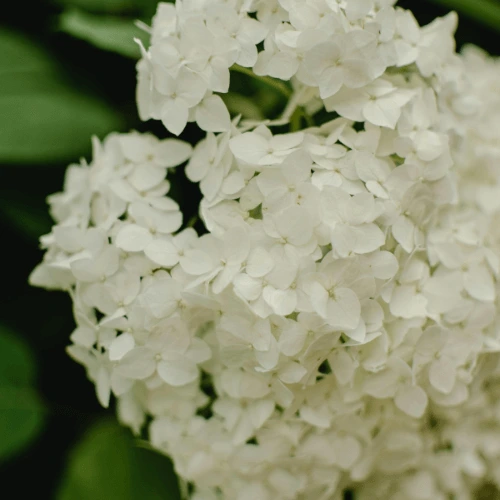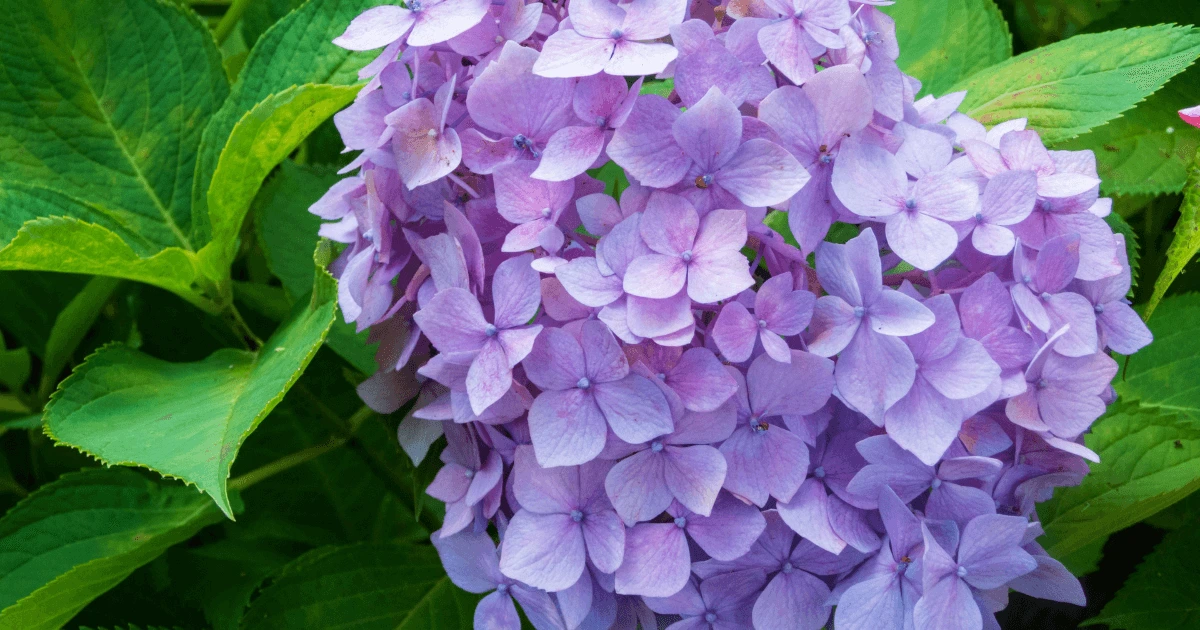Imagine stepping into your garden and being greeted by the breathtaking sight of vibrant purple hydrangeas, their lush blooms glowing in the sunlight. These enchanting flowers aren’t just a feast for the eyes; they’re also a symbol of gratitude, abundance, and heartfelt emotion. Whether you’re a seasoned gardener or just starting, mastering the art of growing and caring for purple hydrangeas can transform your outdoor space into a haven of beauty. Let’s dive into everything you need to know to cultivate these stunning blooms and make your garden truly unforgettable.
In This Article
| Common Name | Hydrangea |
|---|---|
| Botanical Name | Hydrangea spp. |
| Family | Hydrangeaceae |
| Plant Type | Deciduous or Evergreen Shrub |
| Mature Size | 3–12 feet tall and wide (varies by species) |
| Bloom Time | Spring to Late Summer |
| Toxicity | Toxic to pets and humans if ingested |
| Sun Exposure | Partial Shade to Full Sun |
| Soil Type | Well-draining, rich, moist soil |
| Soil pH | 5.0–7.5 (pH affects bloom color) |
| Flower Color | White, pink, blue, purple, red, or green |
| Hardiness Zones | 3–9 (varies by species) |
| Native Area | Japan, Korea, China, Americas |
Purple Hydrangea Care
Caring for purple hydrangeas doesn’t have to be complicated. With a few simple guidelines, you can ensure your hydrangeas thrive and produce those stunning blooms you love. Here is how to give your plants the best care:
1. Choose the Right Location
- Sunlight Needs: Purple hydrangeas typically prefer morning sun and afternoon shade. Too much direct sunlight can cause the blooms to fade, while too little can hinder growth.
- Space to Grow: Ensure your hydrangeas have enough space to expand. Crowded plants may compete for resources, leading to stunted growth.
2. Optimize Soil Conditions
- Ideal pH Level: Hydrangeas thrive in slightly acidic soil (pH 5.5–6.5). For deeper purple hues, adjust the soil using amendments like aluminum sulfate.
- Well-Draining Soil: Ensure the soil retains moisture without becoming waterlogged. Adding organic matter as compost can improve drainage and nutrient content.
3. Water Regularly
- Hydrangeas (Purple Hydrangeas) need consistent moisture, especially during hot summers. Water deeply 2–3 times a week rather than shallow daily watering.
- To prevent diseases, avoid wetting the leaves—focus on the base of the plant instead.
4. Fertilize Thoughtfully
- Use a balanced, slow-release fertilizer in early spring to encourage healthy growth and vibrant blooms.
- Avoid over-fertilizing, as it may lead to lush foliage at the expense of flowers.
5. Mulch for Protection
- Spread a 2–3 inch layer of organic mulch around the base to conserve soil moisture, regulate temperature, and reduce weeds.
- To prevent rot, keep the mulch a few inches away from the stem
6. Monitor for Signs of Stress
- Look for yellowing leaves, wilting, or discolored blooms—these could indicate overwatering, pests, or nutrient deficiencies. Address issues promptly to keep your hydrangeas healthy.
Types of Hydrangea



Hydrangeas come in a dazzling variety of shapes, sizes, and bloom styles, making them a versatile choice for gardens across the U.S. Whether you’re looking for dramatic purple hues or delicate lace-like blossoms, there’s a hydrangea type to suit every gardener’s taste. Let’s explore the most popular varieties:
1. Bigleaf Hydrangea (Hydrangea macrophylla)
- Key Features: Known for its large, round flower clusters, this type often boasts vibrant purple, blue, or pink blooms.
- Ideal For: Adding color to shaded garden beds or borders.
- Care Tip: Bigleaf hydrangeas are highly sensitive to soil pH, so amend your soil to achieve the desired bloom color.
2. Panicle Hydrangea (Hydrangea paniculata)
- Key Features: Produces cone-shaped flower clusters that start white and often fade to pink or lime-green.
- Ideal For: Sunny spots and colder climates, as this variety is hardy and sun-tolerant.
- Care Tip: Prune in late winter or early spring to encourage vigorous blooming.
3. Oakleaf Hydrangea (Hydrangea quercifolia)
- Key Features: Recognizable by its oak-shaped leaves and clusters of white blooms that deepen to pink as they mature.
- Ideal For: Naturalistic gardens or woodland areas.
- Care Tip: This drought-tolerant variety thrives in well-drained soil and partial shade.
4. Lacecap Hydrangea (Hydrangea macrophylla var.)
- Key Features: Features flat flower heads with a ring of showy blooms surrounding tiny, delicate flowers.
- Ideal For: Adding texture and elegance to shaded borders.
- Care Tip: Provide consistent moisture to keep blooms vibrant throughout the growing season.
5. Climbing Hydrangea (Hydrangea anomala petiolaris)
- Key Features: A vigorous climber with fragrant, white lacecap-style blooms and attractive peeling bark.
- Ideal For: Covering walls, trellises, or fences with lush greenery and blooms.
- Care Tip: Ensure sturdy support, as mature plants can become heavy.
Choosing the Right Hydrangea for Your Garden
When selecting a hydrangea, consider your garden’s sunlight, soil type, and climate. Bigleaf hydrangeas thrive in mild conditions with acidic soil, while panicle and oakleaf hydrangeas are better suited for sunny or less temperate regions.
By understanding the unique characteristics of each hydrangea type, you can choose the perfect variety to enhance your garden’s beauty and enjoy their spectacular blooms year after year.
Pruning
Pruning is essential for keeping your hydrangeas healthy, vibrant, and blooming beautifully. However, not all hydrangeas are pruned the same way. Knowing when and how to prune ensures you maintain your plant’s shape, encourage fresh growth, and maximize those stunning blooms.
Why Prune Hydrangeas?
- Improves airflow to reduce diseases’s risk.
- Encourages vibrant, abundant blooms.
- Helps maintain the desired size and shape.
Types of Hydrangeas and Pruning Techniques
1. Bigleaf Hydrangeas (Hydrangea macrophylla)
- When to Prune: After blooming, typically in late summer or early fall.
- Why: These bloom on old wood, meaning next year’s flowers develop on stems from the current year. Pruning too late may remove next season’s buds.
- How:
- Remove spent flowers (deadheading) and weak or damaged stems.
- Avoid cutting back healthy stems with developing buds.
2. Panicle Hydrangeas (Hydrangea paniculata)
- When to Prune: Late winter or early spring before new growth emerges.
- Why: This type blooms on new wood, so pruning encourages strong, fresh stems for larger blooms.
- How:
- Cut back stems by one-third to promote vigorous growth.
- Thin out crowded branches to improve structure and airflow.
3. Oakleaf Hydrangeas (Hydrangea quercifolia)
- When to Prune: Immediately after flowering, usually midsummer.
- Why: Like bigleaf hydrangeas, they bloom on old wood, so pruning later can remove next year’s buds.
- How:
- Remove dead flowers and weak or crossing stems.
- Lightly shape the plant in order to maintain its natural form.
4. Climbing Hydrangeas (Hydrangea anomala petiolaris)
- When to Prune: Late winter or early spring.
- Why: This type requires minimal pruning, mostly for shaping or removing damaged stems.
- How:
- Trim back any overgrown branches.
- Remove dead and weak stems to encourage healthy growth.
General Pruning Tips
- Always use clean, sharp pruning tools to make precise cuts and reduce the risk of spreading diseases.
- Disinfect your tools between plants to avoid cross-contamination.
- Step back periodically while pruning to ensure you’re achieving the desired shape.
Propagating Purple Hydrangea
Propagating hydrangeas is a rewarding way to expand your garden or share your favorite plants with friends and family. Fortunately, hydrangeas are relatively easy to propagate, especially through cuttings. Follow these steps to grow new plants from your existing hydrangeas.
Best Time to Propagate Purple Hydrangeas
- Softwood Cuttings: Take cuttings in late spring or early summer when the stems are still soft and flexible.
- Hardwood Cuttings: For experienced gardeners, hardwood cuttings can be taken in late fall or winter when the plant is dormant.
How to Propagate Hydrangeas Using Softwood Cuttings
1. Select and Cut the Stem
- Choose a healthy stem without flowers. The stem should have at least 2–3 leaf nodes (bumps where leaves emerge).
- Cut a 4–6 inch section just below a node using clean pruning shears.
2. Prepare the Cutting
- Remove the lower leaves to expose the nodes, leaving 2–3 leaves at the top.
- If the remaining leaves are large, trim them in half to reduce water loss.
- Dip the cut end into rooting hormone to encourage faster rooting (optional).
3. Plant the Cutting
- Fill your container with moistened potting mix.
- Make a small hole in the soil and gently insert your cutting, ensuring that at least one node is buried.
- Press gently the soil around the stem to secure it.
4. Create a Humid Environment
- Cover the cutting with a plastic bag or place the container inside a clear plastic dome to maintain humidity.
- Choose a bright, indirect light location to place the container in.
5. Water and Monitor
- Ensure a consistent soil moisture without being waterlogged.
- Check for root development in 3–4 weeks by gently tugging the cutting. Resistance indicates root growth.
Hardwood Cutting Propagation
For hardwood cuttings, follow the same steps but use dormant stems and plant them in a well-drained outdoor bed or pot. These cuttings will root more slowly, typically over a few months.
Tips for Successful Hydrangea Propagation
- Patience is key—some cuttings can take longer to root.
- Avoid direct sunlight, as it can dry out the cuttings.
- If propagating multiple cuttings, label them to keep track of success rates.
Potting and Repotting Hydrangea
Potting and repotting hydrangeas is a simple yet essential process to keep these stunning plants thriving, especially if you’re growing them in containers. With proper care, your hydrangeas will reward you with lush foliage and vibrant blooms year after year.
Why Pot or Repot Hydrangeas?
- Encourage Healthy Growth: Over time, hydrangeas can outgrow their pots, causing root crowding and reduced growth.
- Refresh the Soil: Replacing old soil provides fresh nutrients that improve plant health and blooming potential.
- Prevent Root Rot: A new pot with proper drainage reduces the risk of waterlogged roots.
Selecting the Right Pot
- Size: Choose a pot 2–3 inches larger in diameter than the current one to give roots room to grow.
- Material: Terracotta pots are breathable but may dry out faster, while plastic pots retain moisture better.
- Drainage: Ensure your pot has multiple drainage holes to avoid waterlogging. If necessary, add a layer of gravel to improve drainage.
Best Time to Pot or Repot Hydrangeas
- The ideal time to repot hydrangeas is early spring, just before the growing season.
- Repotting may also be necessary if the plant shows signs like roots growing out of the pot or poor water retention.
Step-by-Step Guide to Potting and Repotting Hydrangeas
1. Prepare the New Pot
- Fill the base of the pot with fresh, well-draining potting mix. A mix containing peat moss, perlite, and compost is ideal for hydrangeas.
- If you’re aiming for purple hydrangea blooms, consider using acidic soil or adding sulfur to adjust the pH level.
2. Remove your Hydrangea from Its Current Pot
- Gently slide the plant out by tilting the pot. If it’s stuck, tap the sides or loosen the edges with a small tool.
- Inspect the roots. Trim any that are damaged, blackened, or overly tangled using sharp, sterilized scissors.
3. Position your Plant in the New Pot
- Place the hydrangea in the center of the pot, ensuring the root ball sits slightly below the rim of the pot.
- Fill in around the root ball with potting mix, pressing gently to remove air pockets. Avoid burying the stem too deeply.
4. Water Thoroughly
- Water the plant immediately after potting to help settle the soil.
Care Tips for Potted Hydrangeas
- Light: Hydrangeas thrive in bright, indirect sunlight.
- Watering: Moderate watering.
- Fertilizing: Apply a balanced, slow-release fertilizer during the growing season to encourage healthy blooms.
- Humidity: If growing indoors, mist the leaves occasionally or use a humidity tray to maintain moisture levels.
Common Signs It’s Time to Repot
- Roots are circling the inside of the pot or growing out of the drainage holes.
- Water pools at the surface or the soil dries out too quickly or.
- The plant’s growth appears stunted or its blooms are less frequent.
Overwintering Hydrangeas
Preparing your hydrangeas for winter is essential to ensure their survival and encourage healthy growth and blooms in the spring. Overwintering hydrangeas doesn’t have to be daunting—just follow these practical tips tailored to your specific hydrangea type and growing conditions.
Why Overwintering is Important
- Protects Against Frost Damage: Hydrangeas, especially less hardy varieties, are vulnerable to freezing temperatures.
- Encourages Better Blooms: Proper winter care helps hydrangeas conserve energy, leading to vibrant flowers in the growing season.
Know Your Hydrangea Type
The type of hydrangea you’re growing influences how you prepare it for winter:
- Bigleaf Hydrangeas (Hydrangea macrophylla): These are less hardy and need extra protection in colder climates.
- Panicle Hydrangeas (Hydrangea paniculata): Generally hardy but benefit from light mulching.
- Smooth Hydrangeas (Hydrangea arborescens): Very cold-hardy and require minimal overwintering care.
- Oakleaf Hydrangeas (Hydrangea quercifolia): Need light mulching and pruning to thrive in winter.
How to Overwinter Outdoor Hydrangeas
1. Mulching for Root Protection
- Spread a 3–4 inch layer of organic mulch, such as straw, pine needles, or shredded bark, around the base of the plant.
- Keep the mulch about 1–2 inches away from the stem to prevent rot.
2. Pruning and Trimming
- Avoid heavy pruning on hydrangeas that bloom on old wood (like bigleaf hydrangeas), as this can remove next season’s flower buds.
- For varieties that bloom on new wood (like panicle or smooth hydrangeas), prune lightly after the first frost.
3. Wrapping for Insulation
- In areas with harsh winters, wrap hydrangeas in burlap or frost cloth to protect the stems and buds.
- Place stakes around the plant, wrap burlap around the stakes, and fill the space with straw or leaves for added insulation.
4. Watering Before Winter
- Water your hydrangeas deeply in late fall before the ground freezes. This helps hydrate the roots and prevents desiccation during winter.
Overwintering Potted Hydrangeas
Potted hydrangeas are more susceptible to cold damage since their roots are exposed to the elements. Here’s how to protect them:
- Move Indoors: Bring the pot into an unheated garage, basement, or shed where temperatures stay between 35–50°F.
- Wrap the Pot: Insulate the pot with bubble wrap or burlap to protect the roots.
- Limit Watering: Water sparingly during winter—just enough to keep the soil slightly moist.
Spring Revival
- As temperatures warm up, gradually remove winter coverings to let your hydrangea acclimate.
- Prune any dead or damaged stems and give the plant a light feeding of balanced fertilizer to jumpstart the growing season.
Troubleshooting Winter Damage
If your hydrangea doesn’t leaf out or bloom as expected, don’t panic:
- Check for Green Tissue: Scratch the bark on stems to see if there’s green underneath, indicating the plant is alive.
- Cut Back to Healthy Growth: Prune dead stems to the base and allow time for new shoots to emerge.
How to Get Hydrangeas to Bloom
Hydrangeas are beloved for their vibrant, show-stopping blooms, but sometimes they can be stubborn about flowering. If your hydrangea isn’t producing the beautiful blossoms you’re hoping for, don’t worry—there are steps you can take to encourage it to bloom. Here’s a guide to help you bring out the best in your hydrangeas.
1. Know Your Hydrangea Type
Understanding your hydrangea variety is the first step to successful blooming:
- Bigleaf Hydrangeas (Hydrangea macrophylla): Bloom on old wood, meaning flower buds form the previous year.
- Panicle Hydrangeas (Hydrangea paniculata): Bloom on new wood, producing flowers on the current season’s growth.
- Smooth Hydrangeas (Hydrangea arborescens): Also bloom on new wood and are more forgiving with pruning.
- Oakleaf Hydrangeas (Hydrangea quercifolia): Bloom on old wood, requiring extra care to preserve flower buds.
2. Ensure Proper Sunlight
- Hydrangeas generally prefer morning sun and afternoon shade. Too much direct sunlight can stress the plant, while too little can hinder flowering.
- For bigleaf and oakleaf hydrangeas, aim for partial shade.
3. Fertilize Smartly
- Use a balanced fertilizer (10-10-10) during the growing season to provide essential nutrients.
- Avoid excessive nitrogen, which promotes lush foliage at the expense of blooms.
- For bigleaf hydrangeas, a phosphorus-rich fertilizer can boost flower production.
4. Prune Carefully
- Pruning mistakes are a common reason hydrangeas don’t bloom.
- Old Wood Bloomers: Only remove dead or damaged wood. Avoid cutting back healthy stems, as this can remove flower buds.
- New Wood Bloomers: Prune in late winter or early spring to encourage fresh growth and flowers.
5. Maintain Ideal Soil Conditions
- Hydrangeas thrive in well-draining, nutrient-rich soil.
- For vibrant purple hydrangeas, maintain slightly acidic soil with a pH of around 5.5 to 6.5. You can amend the soil with sulfur or organic compost to achieve the right balance.
6. Water Consistently
- Hydrangeas are water-loving plants and need consistent moisture, especially during dry spells.
- Water deeply 1 to 2 times a week, ensuring the soil remains moist but not waterlogged.
7. Protect Buds from Frost
- Late-season frost can damage flower buds on old wood varieties.
- Cover your hydrangeas with burlap or frost cloth during unexpected cold snaps to shield developing buds.
8. Address Common Blooming Issues
Age of the Plant
- Young hydrangeas (less than 3 years old) may not bloom as they establish their root systems. Patience is key.
Transplant Shock
- If you’ve recently moved your hydrangea, it might take a season to adjust before blooming again.
Overcrowding
- Dense growth can limit air circulation and light penetration, affecting blooms. Thin out surrounding vegetation if necessary.
Pest Problems
- Inspect for pests like aphids or spider mites, which can stress the plant. Use insecticidal soap or neem oil to fix infestations.
9. Add Mulch for Extra Protection
- A layer of organic mulch around the base of the plant retains soil moisture, regulates temperature, and prevents weed competition.
10. Stay Patient and Observant
Common Pests & Plant Diseases
Hydrangeas are hardy plants, but they’re not immune to pests and diseases. Recognizing the early signs and taking prompt action can help keep your hydrangeas healthy and thriving. Here’s a guide to common issues and how to address them effectively.
1. Common Pests That Affect Hydrangeas
Aphids
- What to Look For: Clusters of small, pear-shaped insects on the undersides of leaves or stems. You might also notice sticky honeydew residue or sooty mold.
- How to Treat: Spray the plant with a strong stream of water to dislodge aphids, or use insecticidal soap or neem oil.
Spider Mites
- What to Look For: Fine webbing on leaves, yellow or stippled foliage.
- How to Treat: Increase humidity around the plant and spray with insecticidal soap. In severe cases, use a miticide.
Japanese Beetles
- What to Look For: Metallic green beetles chewing through leaves, leaving skeletonized foliage.
- How to Treat: Handpick beetles in the early morning and drop them into soapy water. Apply neem oil to address further infestations.
Scale Insects
- What to Look For: Brown, shell-like bumps on stems and leaves.
- How to Treat: Remove scales manually with a soft brush and apply horticultural oil.
Slugs and Snails
- What to Look For: Irregular holes in leaves and silvery trails on the plant or soil.
- How to Treat: Use slug pellets, diatomaceous earth, or a natural deterrent like crushed eggshells around the base of the plant.
2. Common Diseases in Hydrangeas
Powdery Mildew
- What to Look For: White, powdery patches on leaves and stems.
- How to Treat: Improve air circulation by spacing plants properly. Use a fungicide or a homemade solution of baking water and soda .
Leaf Spot
- What to Look For: Brown or black spots on leaves, often caused by fungal or bacterial infections.
- How to Treat: Remove and dispose of infected leaves. Apply a copper-based fungicide if needed.
Botrytis Blight
- What to Look For: Gray, fuzzy mold on flowers and leaves, especially in damp conditions.
- How to Treat: Remove affected parts of the plant and improve airflow. Apply a fungicide for severe cases.
Root Rot
- What to Look For: Wilting, yellowing leaves, and mushy, discolored roots caused by overwatering or poorly draining soil.
- How to Treat: Improve drainage, reduce watering, and consider replanting in fresh soil.
Rust
- What to Look For: Orange or rusty-colored spots on the undersides of leaves.
- How to Treat: Remove infected leaves and apply a sulfur-based fungicide.
3. Preventative Measures to Protect Your Hydrangeas
- Proper Spacing: Ensure adequate air circulation by planting hydrangeas with enough room to grow.
- Watering at the Base: Avoid overhead watering to prevent wet foliage, which encourages fungal growth.
- Regular Inspection: Check your plants weekly for early signs of pests or diseases.
- Sanitation: Remove fallen leaves and debris around the plant base to minimize disease risks.
- Healthy Soil: Maintain nutrient-rich, well-draining soil to boost plant immunity.
4. Natural Remedies and Eco-Friendly Solutions
- Garlic Spray: Repels pests like aphids and mites. Mix crushed garlic with water and spray onto plants.
- Companion Planting: Grow pest-repelling plants like marigolds nearby to protect hydrangeas.
- Organic Mulch: Acts as a barrier against pests like slugs while improving soil health.
Common Problems With Hydrangea
Hydrangeas are stunning additions to any garden, but even the most seasoned gardeners encounter issues with these beautiful plants. From drooping leaves to stubbornly green blooms, here’s a guide to identifying and solving common hydrangea problems to keep your garden thriving.
1. Wilting or Drooping Leaves
Causes:
- Underwatering: Dry soil can stress hydrangeas, causing leaves to droop.
- Overwatering: Saturated soil can lead to root rot and wilting.
Solutions:
- Check soil moisture regularly. Water deeply only when the top inch of the soil feels too dry.
- Ensure proper drainage to prevent waterlogged roots.
2. Hydrangea Not Blooming
Causes:
- Incorrect Pruning: Cutting stems at the wrong time can remove flower buds, especially in old wood bloomers like bigleaf hydrangeas.
- Insufficient Sunlight: Lack of sunlight can prevent blooms.
- Nutrient Imbalance: Excess nitrogen promotes leafy growth but hinders flowering.
Solutions:
- Learn your hydrangea type and prune accordingly. Avoid pruning old wood bloomers in late fall or early spring.
- Relocate or trim nearby plants to provide adequate sunlight.
- Use a balanced or phosphorus-rich fertilizer to encourage blooming.
3. Yellowing Leaves
Causes:
- Overwatering: Too much water can suffocate roots and cause leaves to yellow.
- Nutrient Deficiency: Lack of iron or magnesium often leads to yellowing with green veins (chlorosis).
Solutions:
- Adjust watering habits and improve soil drainage.
- Test the soil and amend it with iron chelates or magnesium sulfate (Epsom salts) if needed.
4. Brown or Crispy Leaf Edges
Causes:
- Heat Stress: High temperatures and excessive sun can scorch leaves.
- Low Humidity: Dry air exacerbates stress.
Solutions:
- Provide shade during the hottest parts of the day, especially for bigleaf hydrangeas.
- Mulch around the plant base to retain moisture and improve humidity.
5. Hydrangea Turning Green Instead of Blue or Pink
Causes:
- Soil pH: Color changes are tied to soil acidity. Alkaline soil produces pink blooms, while acidic soil leads to blue. Neutral soil often results in greenish hues.
Solutions:
- For blue flowers, lower soil pH with aluminum sulfate or sulfur.
- For pink flowers, raise pH with lime.
6. Stunted Growth
Causes:
- Poor Soil Quality: Lack of nutrients can hinder growth.
- Overcrowding: Competition from nearby plants limits resources.
Solutions:
- Add an organic compost or a slow-release fertilizer to enrich the soil.
- Thin out surrounding plants to improve airflow and nutrient availability.
7. Leaf Spot or Mold Issues
Causes:
- High Humidity: Excess moisture can lead to fungal infections.
- Poor Air Circulation: Dense foliage traps moisture.
Solutions:
- To avoid wetting leaves, water at the base.
- Space plants appropriately and prune for better airflow.
8. Pests
While pests like aphids and spider mites are common, their damage can weaken hydrangeas and exacerbate other problems.
Solutions:
- Regularly inspect your plants and ensure treating infestations with insecticidal soap or neem oil.
- Use organic mulch to deter soil-dwelling pests.
9. Frost Damage
Causes:
- Late spring frosts can kill new growth, leading to bare spots or a lack of blooms.
Solutions:
- Cover hydrangeas with burlap or frost cloth during unexpected cold snaps.
- Choose frost-hardy varieties if you live in cooler climates.
10. Hydrangea Growing Too Large or Unruly
Causes:
- Lack of regular pruning can cause hydrangeas to grow beyond their space.
Solutions:
- Prune appropriately based on your hydrangea type to control size and shape.
FAQ
How do I make my hydrangea purple?
To achieve purple blooms, adjust your soil’s pH to a range between 5.5 and 6.5. This pH level balances the aluminum availability, which affects the flower’s color. Use soil amendments like garden lime to raise pH or aluminum sulfate to lower it, and test regularly to maintain the desired range.
Are purple hydrangeas natural?
Yes, purple hydrangeas can occur naturally depending on the soil pH and the specific hydrangea variety. Certain types like bigleaf hydrangeas (Hydrangea macrophylla) are more likely to display purple hues due to their sensitivity to soil chemistry.
What does a purple hydrangea symbolize?
Purple hydrangeas symbolize deep understanding, abundance, and a sense of pride. They are often associated with gratitude and heartfelt emotions, making them a popular choice for special occasions and meaningful gifts.
Is blue hydrangea rare?
Blue hydrangeas are not rare but depend on highly acidic soil (pH below 5.5) to develop their striking color. Regions with naturally acidic soil or gardeners who use aluminum sulfate can produce blue blooms more easily.
Conclusion
Caring for purple hydrangeas doesn’t have to be a mystery. From choosing the right soil to mastering pruning and pest control, each step brings you closer to creating a garden filled with vibrant, eye-catching blooms. Whether you’re dealing with stubborn blooms or aiming for perfect purple shades, these tips will set you up for success.
If you loved this guide, subscribe to our newsletter for more expert gardening tips, tricks, and exclusive content straight to your inbox. Let’s grow together!

